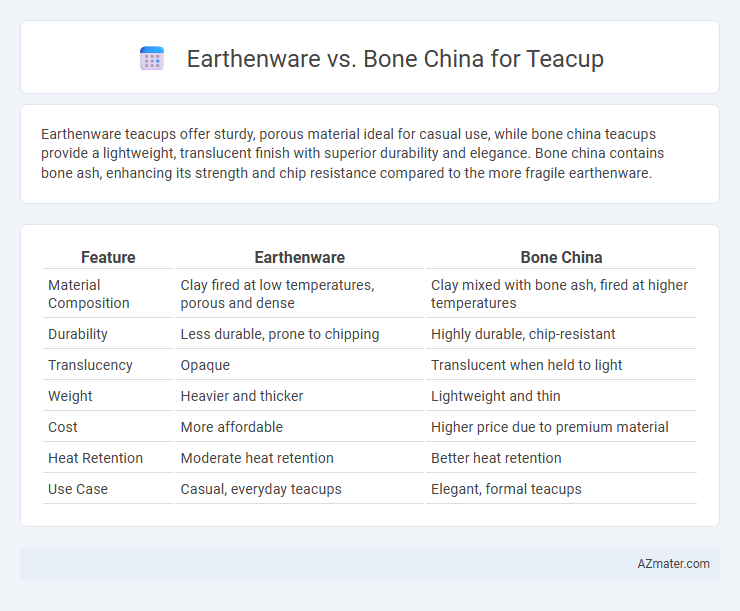Earthenware teacups offer sturdy, porous material ideal for casual use, while bone china teacups provide a lightweight, translucent finish with superior durability and elegance. Bone china contains bone ash, enhancing its strength and chip resistance compared to the more fragile earthenware.
Table of Comparison
| Feature | Earthenware | Bone China |
|---|---|---|
| Material Composition | Clay fired at low temperatures, porous and dense | Clay mixed with bone ash, fired at higher temperatures |
| Durability | Less durable, prone to chipping | Highly durable, chip-resistant |
| Translucency | Opaque | Translucent when held to light |
| Weight | Heavier and thicker | Lightweight and thin |
| Cost | More affordable | Higher price due to premium material |
| Heat Retention | Moderate heat retention | Better heat retention |
| Use Case | Casual, everyday teacups | Elegant, formal teacups |
Introduction to Teacup Materials
Earthenware and bone china represent two distinct materials commonly used for teacups, each offering unique properties and aesthetics. Earthenware is a porous, dense ceramic fired at lower temperatures, known for its rustic charm and durability. Bone china, composed of bone ash, feldspathic material, and kaolin, is renowned for its translucency, lightweight feel, and exceptional strength, making it a luxurious choice for fine teacups.
What is Earthenware?
Earthenware is a type of pottery made from natural clay fired at lower temperatures, resulting in a porous and slightly coarse texture ideal for everyday teacups. Compared to bone china, earthenware offers a rustic charm with its thicker walls and matte finish but lacks the translucency and delicate strength of bone china teacups. Its affordability and durability make earthenware a popular choice for casual or rustic tea settings.
What is Bone China?
Bone china is a type of porcelain known for its high levels of whiteness, translucency, and strength due to the inclusion of bone ash in its composition, typically around 25-50%. Compared to earthenware, bone china offers superior durability and a delicate, lightweight feel, making it ideal for fine teacups that require elegance and resilience. Its heat retention properties and smooth, glass-like finish enhance the overall tea-drinking experience while maintaining resistance to chipping and cracking.
Key Differences Between Earthenware and Bone China
Earthenware teacups are made from porous clay fired at lower temperatures, resulting in a heavier, more rustic feel and greater fragility compared to bone china. Bone china incorporates bone ash in its composition, producing a lighter, more translucent, and highly durable teacup that resists chipping and cracking. The key differences lie in weight, durability, translucency, and firing temperature, with bone china offering superior strength and elegance ideal for fine dining settings.
Durability and Strength Comparison
Earthenware teacups are known for their rustic charm but tend to be less durable and more prone to chipping due to their porous, softer clay composition. Bone china teacups, crafted with bone ash, silica, and kaolin, offer superior strength, chip resistance, and a lightweight yet sturdy structure that withstands daily use better. The high-fired production process of bone china enhances its mechanical durability, making it an ideal choice for long-lasting teacups compared to traditional earthenware.
Aesthetics and Design Opportunities
Earthenware teacups offer a rustic charm with their thick, porous texture and matte finishes, making them ideal for handcrafted, artisanal designs. Bone China teacups boast translucency and a delicate, smooth surface that allows for intricate, detailed patterns and elegant, refined aesthetics. The choice between them influences design versatility, with earthenware favoring bold, earthy tones and bone china enhancing fine, sophisticated artistry.
Weight and Handle Comfort
Earthenware teacups are typically heavier and offer a more substantial feel, which can enhance stability but may cause hand fatigue during extended use. Bone china teacups are lighter and thinner, providing a delicate touch with ergonomic handles designed for comfort and ease of grip. The lightweight nature and refined handle design of bone china make it preferable for users seeking comfort and prolonged use without strain.
Heat Retention and Tea Experience
Earthenware teacups excel in heat retention due to their thick, porous structure, keeping tea warm longer while offering a rustic, tactile experience. Bone china, known for its thin, lightweight composition and high translucency, provides a delicate feel but loses heat more rapidly compared to earthenware. The choice impacts tea enjoyment: earthenware's warmth enhances flavor depth, whereas bone china's elegance elevates presentation without maintaining temperature as effectively.
Maintenance and Care Requirements
Earthenware teacups require gentle hand washing with mild detergent to prevent chipping and are more porous, making them prone to staining if not dried thoroughly. Bone china teacups boast a more durable, non-porous surface that resists stains and can often withstand dishwasher use, though hand washing is recommended to preserve their delicate translucency and gold trim. Proper storage with padding and avoiding extreme temperature changes extend the lifespan of both materials, with bone china generally demanding less maintenance due to its higher strength and resistance.
Choosing the Best Material for Your Teacup
Earthenware teacups offer durability and a rustic charm with their thicker walls and porous nature, ideal for everyday use, while bone china is prized for its lightweight feel, translucency, and elegant appearance, making it perfect for formal settings. Bone china's high calcium phosphate content contributes to its strength and chip resistance despite its delicate look, whereas earthenware requires careful handling due to its brittleness and susceptibility to chipping. Selecting the best material depends on whether you prioritize aesthetic refinement and lightness with bone china or practicality and a traditional feel with earthenware.

Infographic: Earthenware vs Bone China for Teacup
 azmater.com
azmater.com